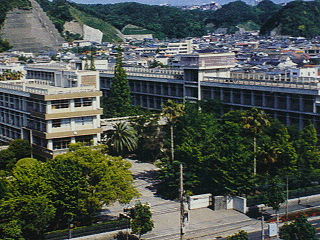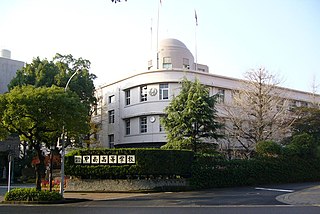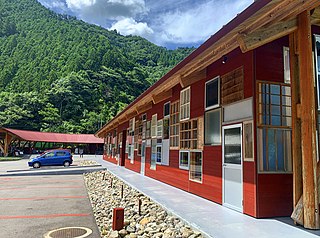
Nagashima is a town located in Izumi District, Kagoshima Prefecture, Japan.

Yūsui is a town located in Aira District, Kagoshima Prefecture, Japan.
Ninja Captor is a Japanese tokusatsu TV series which aired from April 7, 1976, to January 26, 1977. It appeared on TV Tokyo, Channel 12, and was produced by Toei Company, Ltd. Ninja Captor is similar to Toei's own Super Sentai series and aired during the run of Himitsu Sentai Gorenger.

Kagoshima Prefectural Tsurumaru Senior High School is an upper secondary school in Kagoshima City, Kagoshima Prefecture, Japan. It is a co-educational public school.

The invasion of Ryukyu by forces of the Japanese feudal domain of Satsuma took place from March to May of 1609, and marked the beginning of the Ryukyu Kingdom's status as a vassal state under the Satsuma domain. The invasion force was met with stiff resistance from the Ryukyuan military on all but one island during the campaign. Ryukyu would remain a vassal state under Satsuma, alongside its already long-established tributary relationship with China, until it was formally annexed by Japan in 1879 as the Okinawa Prefecture.
Kunoichi is a Japanese cant term for "woman". In popular culture, it is often used for female shinobi or practitioner of ninjutsu (ninpo). The term was largely popularized by novelist Yamada Futaro in his novel Ninpō Hakkenden (忍法八犬伝) in 1964.
The Thai Japanese Association School is a Japanese school located in Huai Khwang District, Bangkok on Rama 9 Road. It is sponsored by the Thai-Japanese Association. It is the school with the largest campus in Bangkok, and one of the two Japanese schools in Bangkok. It allows students from junior school Grade 1 students to middle school Grade 3 students to learn. The school only allows students with a Japanese nationality to study.

Reimeikan, Kagoshima Prefectural Center for Historical Material opened in Kagoshima, Japan, in 1983. The museum, located in the grounds of Tsurumaru Castle, exhibits materials relating to the history and culture of Kagoshima Prefecture.

The Shanghai Japanese School (SJS) is a Japanese international school serving primary and junior high school levels in Shanghai. It has two campuses, one in Hongqiao and one in Pudong. The school's teachers are Japanese citizens. The school also has a senior high school component.
Denrinbō Raikei , also known as Benkei Musō was Chinese-born Japanese martial artist, ninja, swordsman, and Yamabushi. He belonged to Hitoyoshi Domain as ninja. He was thought to be the head of ninja group, Ura-Taisha(裏タイ捨) or Sagara-ningun(相良忍軍).
Ninja-Russia relation refers to the international relations between the Ninja, Japanese covert agents, and historical Russian countries such as the Russian Empire and the Soviet Union. Russia was the first western country that ninja confronted and among the earliest countries that recognized the existence of ninja and researched them.

Kagoshima Prefectural Konan Senior High School is an upper secondary school in Kagoshima City, Kagoshima Prefecture, Japan. It is a co-educational public school.

Kamikatsu Zero-waste Center is a waste management and materials recovery facility that recycles over 80 percent of the waste produced in Kamikatsu, which is much higher than the 20 percent average in the rest of Japan. It is at the center of what The Washington Post describes as an "ambitious path toward a zero-waste life".







